Potassium Adsorption in Soils Derived from Four Different Parent Materials Under Oil Palm Cultivation
| Received 19 Mar, 2025 |
Accepted 23 Jun, 2025 |
Published 30 Sep, 2025 |
Background and Objective: Potassium is the most important nutrient element necessary for oil palm yield improvement. Its adsorption in soils of four different parent materials of the oil palm was studied at the Nigerian Institute for Oil Palm Research. Materials and Methods: Soil samples obtained from profile pits sunk under four different parent materials of the oil palm, namely alluvium, coastal plain sand, basement complex and shale mixed with sandstone and clay, were used for adsorption studies to determine their K-adsorptive capacities. Results: Texturally, the soils ranged from loamy sand to sandy loam and exhibited different adsorptive capacities after equilibration. In soils under Coastal Plain Sand parent materials, Freundlich, Langmuir and Temkin Adsorption Isotherms had r2 values of 97, 26 and 57%, respectively. This trend was also observed in the other soils. Langmuir and Temkin reflected the adsorptive capacities of soils under alluvium and coastal plain sand, while Freundlich and Temkin’s adsorptive models reflected the adsorptive capacities of soils under basement complex rocks and shale mixed with sandstone and clay. Conclusion: The adsorptive capacity of the soils under alluvium was rapid, though it took a longer time to reach equilibration when compared to others. The study therefore showed that potassium fertilization made to improve oil palm yields in soils under Basement Complex Rocks and Shale Mixed with Sandstone and Clay could be done less frequently because of their high K adsorptive capacities while K application in soils under alluvium and Coastal Plain Sand Parent materials could be done more frequently because of their low K adsorptive capacities.
| Copyright © 2025 Stanley et al. This is an open-access article distributed under the Creative Commons Attribution License, which permits unrestricted use, distribution, and reproduction in any medium, provided the original work is properly cited. |
INTRODUCTION
Soils of the oil palm belt are varied in mineralogy and mineral content. The bulk of the soils, especially those in the Southern part of the country, are largely sandy at the top with varied underlying soil materials that consist largely of Iron, manganese and aluminum oxide constituents. Those in the Southwestern part of the country are largely of basement complex origin and consist of rock fragments underlying different soil materials at different stages of weathering. Soils of shale origin, besides those of basement complex origin, are also common. These variations are also common in the Southeastern part of the country. These varied mineralogy and chemistry influence the performance of oil palm on such soils. Potassium is a very important element for all crops and a large amount of it is used by oil palm in the production of bunches and maintenance of cellular activities1. Many soils in Nigeria are deficient in K, with wide variations in their status2,3. Soils under oil palm in the Southern part of Nigeria are low in K status2. The low status of K in soils under oil palm is due to three factors: Rapid uptake and utilization by oil palm of water soluble and exchangeable K; removal of K through harvesting of fresh fruit bunches and leaching of K beyond the roots of the palms1,4. The concentration of K in soils under oil palm depends upon the rate of removal by palms and this is usually rapid under oil palm plantation system. It also depends on the rate which adsorbed K is desorbed from the adsorbed phase. Knowledge of the variation in K adsorption among soils under oil palm and the equilibration between quantity and intensity to determine soil K capacity and intensity is necessary to predict, not only the fate of added K fertilizers but also the capacity of the soil to replenish soil solution K when depleted as a result of oil palm uptake5,6. There is currently a dearth of information on the adsorption pattern of soil K, especially concerning time. This study was conducted to determine the effect of contact time on the potassium concentration and the extent of potassium adsorption characteristics of the selected soils by comparing different adsorption models.
MATERIALS AND METHODS
Study area: The study was undertaken in four states of Southern Nigeria. The field study commenced on the 1st of April of 2022 and ended on May 13th of the same year. The laboratory study commenced on June 26th of 2022 and ended on August 27th of the same year. The study was carried out on oil palm plantations under soils of four different parent materials, viz, alluvium, coastal plain sand, basement complex rocks and shale mixed with sandstone and clay. The soils under the different parent materials were sampled randomly at 0-30 cm, composited for each location and labeled. The samples were air-dried in the laboratory and passed through a 2 mm sieve, where other parameters were determined as shown below:
Determination of particle size distribution of the soils: The soils were air-dried and passed through a 2 mm sieve and thereafter analyzed for particle size distribution using the hydrometer method7.
The 2.5 g of the soil samples were put in 25 mL solutions of 0.01M CaCl2 at 25+1°C that contained potassium concentrations of 0, 4, 8, 16 and 32 mg/L and shaken for 2, 4, 8, 16 and 32 hrs to determine the time necessary to reach steady state. The contents were filtered using Whatman No. 42 filter papers: The concentration levels of potassium in the filtrate were measured using a flame photometer8. Adsorption isotherms were constructed9. The amount of K adsorbed was determined as given below:
where, ΔK is the change in the amount of K (quantity factor (Q)) in solution and represents the amount of K adsorbed, CKi and CKf are the initial K concentrations added and final equilibrium concentrations of K in solution, respectively. The V and M are the solution volume and mass of the soil used. The K adsorption data were fitted into the following adsorption models9,10.
Freundlich adsorption equation:
This was linearized as:
where, x/m is the mass of adsorbed K per unit mass of soil (mg/kg, C is the equilibrium K concentration of solutions (mg/L), a and b are constants obtained from the intercept and slope, respectively.
Langmuir adsorption equation:
where, C is the equilibrium solution K concentration (mg/L), x/m is the mass of K adsorbed per unit mass of soil (mg/kg), k is a constant related to the bonding energy of K to the soil, while b is the maximum K adsorption capacity of the soil.
Temkin adsorption equation:
where, x/m is the mass of K adsorbed per unit mass of soil (mg/kg), C is the equilibrium solution K concentration (mg/L), a and b are constants. As with the Freundlich equation, the values of a and b were obtained from the intercept and slope, respectively.
RESULTS
Particle size distribution of the soils: Soils under Alluvium, Coastal Plain Sand and Shale mixed with sandstone and clay were Loamy Sand in texture, while those under Basement complex rocks were Sandy Loam (Table 1).
Potassium adsorption by soils of the four different parent materials: In Fig. 1, the four soils, potassium adsorption followed the same pattern of increasing with increasing amounts of added K (Fig. 1).
Potassium adsorption by soils of the four different parent materials as a function of time: This is shown in Fig. 2-5. In alluvium, potassium adsorption increased with time and was rapid after 2 and 6 hrs of equilibration, after which it became constant till 36 hrs of quilibration, when no detectable change was noticed (Fig. 2). In soils under Coastal Plain Sand, potassium adsorption increased with time and reached equilibrium after 12 hrs of quilibration, after which no further change was noticed (Fig. 3).
| Table 1: | Particle size distribution of soils of the different parent materials | |||
| Parent material | Sand (gk/g) | Silt (gk/g) | Clay (gk/g) | Textural class |
| Alluvium (Agbarho) | 870.10ab | 52.70a | 73.20a | Loamy sand |
| Coastal plain sand (NIFOR) | 870.70b | 30.30b | 98.50a | Loamy sand |
| Basement complex (Onishere) | 793.50c | 91.60c | 116.40a | Sandy loam |
| Shale mixed with sandstone and clay | 855.90abd | 37.90b | 106.20a | Loamy sand |
| Adapted from Osayande et al.11 | ||||
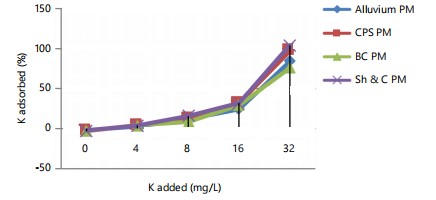
|
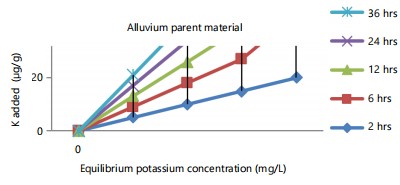
|
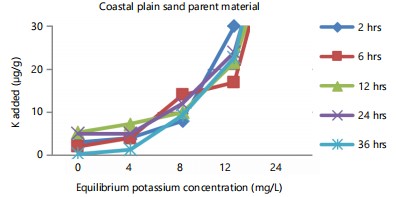
|

|
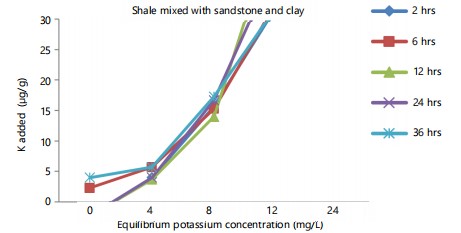
|
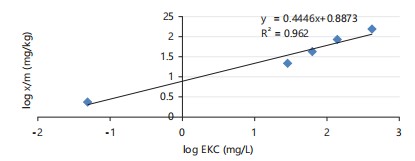
|
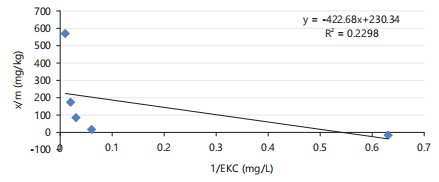
|
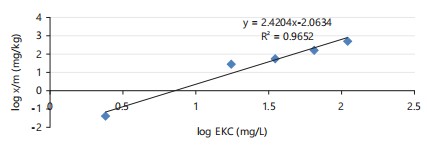
|
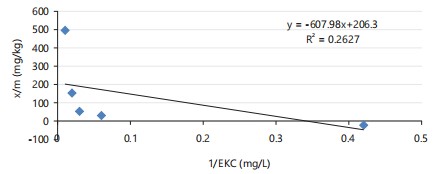
|

|
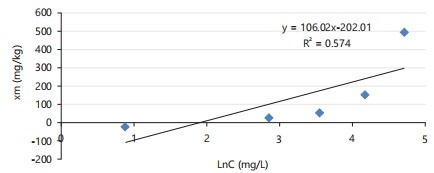
|
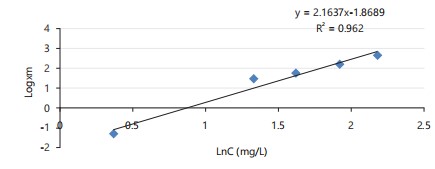
|
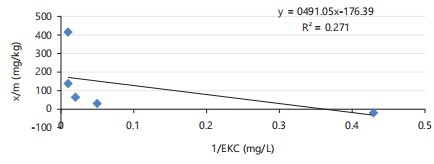
|

|
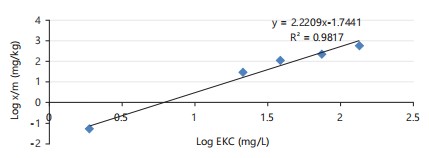
|
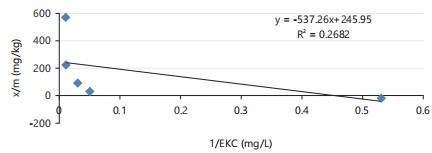
|
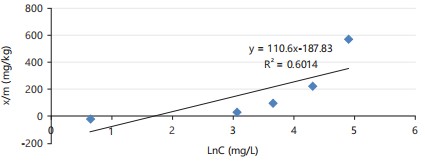
|
This trend was also observed with soils under the Basement Complex (Fig. 4). In soils under Shale Mixed with Sandstone and Clay, equilibrium was reached after 8 hrs of equilibration, after which no further K adsorption was noticed (Fig. 5).
Comparisons of the three different adsorption models used in the study: This is shown in Fig. 6-17. In soils under alluvium, the Freundlich Adsorption Isotherm (FAI) had an r2 value of 0.98% (Fig. 6), langmuir adsorption isotherm (LAI) had an r2 value of 23% (Fig. 7) while temkin adsorption isotherm (TAI) had an r2 value of 59% (Fig. 8). In soils under Coastal Plain Sand parent materials, Freundlich, Langmuir and Temkin Adsorption Isotherms had r2 values of 97, 26 and 57%, respectively Fig. 9-11. In soils under Basement Complex Rocks, Freundlich, Langmuir and Temkin Adsorption Isotherms had r2 values of 96, 27 and 61%, respectively (Fig. 12-14). In soils under Shale mixed with Sandstone and Clay, Freundlich, Langmuir and Temkin Adsorption Isotherms had 98, 27 and 60%, respectively (Fig. 15-17).
DISCUSSION
While the Freundlich adsorption Isotherm suggested a high adsorptive capacity of the soils, considering the r2 values of between 96 and 98%, Temkin’s and Langmuir’s adsorptive models seemed to give a true adsorptive capacity of the soils. This is similar to the findings of Osayande et al.11, who opined that the sorption characteristics of soils determined with the Freundlich models usually have high values for the coefficient of determination. The possible explanations given for the high sorption characteristics as determined by Freundlich adsorption models for soils under Alluvium (96%) and Coastal Plain Sands (97%) are that the latter usually contains a high proportion of Iron and Aluminum oxides that are capable of increasing the sorption characteristics of the soils under Coastal Plain Sand Parent materials12. While, Umoh et al.13 showed that the deposition of cementing materials, also of Iron, Manganese and Aluminum oxide origin, could explain the high sorption characteristics of soils by the Freundlich models. Except for soils under Basement Complex Rocks that are rich in 2:1 montmorillonite clay mineral with high affinity to fix or sorb K, soils under alluvium and coastal plain sands are poor in the 2:1 mineral and are therefore rich in the 1:1 type of clay minerals14. This study showed a high adsorptive capacity of the soil under Basement Complex Rocks using both the Freundlich and Temkin models. The high adsorptive capacities of soils under Basement Complex Rocks of both the Freundlich and Temkin models agree with Gartley and Sims15 and Gichangi et al.16, who showed that soils under basement complex and shale had higher adsorptive capacities. It was therefore concluded that soils under Basement complex rocks had higher capacities to retain moisture and, by extension, nutrients. It has been shown that soils with higher capacities to retain nutrients and water contain higher clay contents, which are also capable of fixing or adsorbing nutrient elements depending on the prevailing environmental soil conditions17,18. Soils under Basement complex rocks and Shale mixed with Sandstone and Clay were similar in their adsorptive capacities, as shown in the three different adsorptive models. Concerning the Freundlich adsorption isotherm, Soils under Basement complex rocks and Shale mixed with Sandstone and Clay had r2 values of 96 and 98%, respectively. For Langmuir, the r2 values were 27% respectively, while the r2 values for Temkin’s were 61 and 60%, respectively. Similarly, soils under alluvium and coastal plain sands had the same trend of adsorptive capacities, such that, concerning the Freundlich adsorption isotherm, soils under alluvium and coastal plain sands had r2 values of 98 and 96%, respectively. With Langmuir, their r2 values were 23 and 26%, respectively, while with Temkin’s model, the r2 values were 59 and 57%, respectively. Knowledge of the properties and characteristics of these soils indicated that the Freundlich adsorption isotherm overshot the adsorptive capacities of these soils11. The Langmuir adsorptive model seemed to suggest a very low adsorptive capacity of the four soils, which reflects the nature of soils under alluvium and coastal plain sand parent materials10. Both soils were sandy, especially at the sampling depth of 0-30 cm. This may not reflect the true adsorptive capacities of soils under basement complex rocks and shale mixed with sandstone and clay, which was reflected by Freundlich and Temkin’s adsorption isotherms. The implication of these for K fertilization to palms is that soils under alluvium and coastal plain sands may require frequent K fertilization, as very little is adsorbed on the soil exchange complex. In soils under Basement complex rocks and Shale mixed with Sandstone and Clay, K fertilization could be made to palms at predetermined intervals, as large amounts could be adsorbed on the soil exchange complex.
CONCLUSION
The study concluded that the soils under the four different parent materials of the oil palm, namely alluvium, coastal plain sand, basement complex and shale mixed with sandstone and clay, exhibited different adsorptive capacities. Langmuir and Temkin reflected the adsorptive capacities of soils under alluvium and coastal plain sand, while Freundlich and Temkin’s adsorptive models reflected the adsorptive capacities of soils under Basement complex rocks and Shale mixed with sandstone and clay. The implication of these for K fertilization to palms is that soils under alluvium and coastal plain sands may require frequent K fertilization to compensate for the low adsorptive capacities of Langmuir and Temkin’s models. In soils under Basement complex rocks and Shale mixed with Sandstone and Clay, K fertilization could be made to palms at predetermined intervals, as large amounts could be adsorbed on the soil exchange complex, as shown in the high adsorptive capacities of the soils by Freundlich and Temkin’s models. The three models are therefore useful for studying the variations in soils of the oil palm belt for K management.
SIGNIFICANCE STATEMENT
This study identified the varying potassium (K) adsorptive capacities of soils derived from different parent materials. Basement Complex rocks, Shale Mixed with Sandstone and Clays, Alluvium and Coastal Plain Sand, which could be beneficial for optimizing potassium fertilizer application and improving oil palm yield sustainability. This study will assist researchers in uncovering critical areas of nutrient retention and fertilizer-use efficiency in oil palm soils that have remained unexplored by many. Consequently, a new theory on soil-specific potassium management strategies in oil palm cultivation may be developed.
ACKNOWLEDGMENT
The authors wish to thank the Executive Director of the Nigerian Institute for oil palm Research (NIFOR) for his assistance. The corresponding author wishes to acknowledge the effort of colleagues who read the manuscript and made valuable contributions.
REFERENCES
- Efosa, O.P., O.E. Robert and O.E. James, 2020. Relationship between some thermodynamic properties and yield parameters of oil palm in an ultisol. Ecologia, 10: 71-77.
- Osayande, P.E., E.R. Orhue, J.O. Ehigiator and P.O. Oviasogie, 2022. Potassium status of soils under three different parent materials of the oil palm (Elaeis guineensis Jacq). Chem. Mater. Res., 14: 1-11.
- Taiwo, A.A., M.T. Adetunji, J.O. Azeez and T. Bamgbose, 2010. Potassium supplying capacity of some tropical alfisols in Southwest Nigeria as measured by intensity, quantity and capacity factors. Nutr. Cycling Agroecosyst., 86: 341-355.
- Woittiez, L.S., M.T. van Wijk, M. Slingerland, M. van Noordwijk and K.E. Giller, 2017. Yield gaps in oil palm: A quantitative review of contributing factors. Eur. J. Agron., 83: 57-77.
- Efosa, O.P., O.E. Robert and O.P. Obasogie, 2024. Potassium dynamics and relationships with oil palm bunch yields in ultisols of NIFOR main station. Trends Agric. Sci., 3: 9-16.
- Abdul Hannan, A.M. Ranjha, Rahmatullah, M. Waqas and A. Niaz, 2007. Potassium adsorption characteristics of four different textured alkaline calcareous soils. Pak. J. Agric. Sci. 44: 242-247.
- Gee, G.W. and D. Or, 2002. Particle Size Distribution. In: Methods of Soil Analysis, Part 4. Physical Methods, Dane, J.H. and G.C. Topp (Eds.). SSSA Book, Malison, WI, pp: 255-293.
- Motsara, M.R. and R.N. Roy, 2008. Guide to Laboratory Establishment for Plant Nutrient Analysis. 1st Edn., Food and Agriculture Organization of the United Nations, Rome, Italy, ISBN: 9789251059814, Pages: 204.
- Pal, Y., R.J. Gilkes and M.T.F. Wong, 1999. The forms of potassium and potassium adsorption in some virgin soils from South-Western Australia. Aust. J. Soil Res., 37: 695-710.
- Efosa, O.P., U.C. Stanley, E. Stanley and O.E. Robert, 2021. Relationship between soil organic matter and some physical properties in selected soils of the oil palm belt of Nigeria. J. Nat. Sci. Res., 12: 1-7.
- Osayande, P.E., P.O. Oviasogie, E.R. Orhue, B.E. Awanlemhen and E. Oko-Oboh, 2017. Phosphorus sorption in hydromorphic soils overlying alluvium and coastal plain sand parent materials in Delta State, Nigeria. Commun. Soil Sci. Plant Anal., 48: 955-962.
- Gérard, F., 2016. Clay minerals, iron/aluminum oxides, and their contribution to phosphate sorption in soils-a myth revisited. Geoderma, 262: 213-226.
- Umoh, F.O., S.M. Udo and A.E. Sunday, 2023. Determination of potassium sorption characteristics of soils derived from three diverse parent materials in Akwa Ibom State. Direct Res. J. Agric. Food Sci., 11: 198-205.
- Tamungang, N.E.B., M.Z.A. David, M.N. Alakeh and O.A. Adalbert, 2016. Phosphorus adsorption isotherms in relation to soil characteristics of some selected volcanic affected soils of Foumbot in the west region of Cameroon. Int. J. Soil Sci., 11: 19-28.
- Gartley, K.L. and J.T. Sims, 1994. Phosphorus soil testing: Environmental uses and implications. Commun. Soil Sci. Plant Anal., 25: 1565-1582.
- Gichangi, E.M., P.N.S. Mnkeni and P. Muchaonyerwa, 2008. Phosphate sorption characteristics and external P requirements of selected South African soils. J. Agric. Rural Dev. Trop. Subtropics, 109: 139-149.
- Bilal, A., A.M. Ranjha, Rahmatullah and M. Rashid, 2007. Determining model based phosphorous fertilizer requirement for canola crop. Pak. J. Agric. Sci., 44: 110-116.
- Mnthambala, F., J.H. Maida, M.W. Lowole and V.H. Kabambe, 2015. Phosphorus sorption and external phosphorus requirements of ultisols and oxisols in Malawi. J. Soil Sci. Environ. Manage., 6: 35-41.
How to Cite this paper?
APA-7 Style
Stanley,
U.C., Samuel,
A.O., Efosa,
O.P. (2025). Potassium Adsorption in Soils Derived from Four Different Parent Materials Under Oil Palm Cultivation. Trends in Environmental Sciences, 1(3), 230-238. https://doi.org/10.21124/tes.2025.230.238
ACS Style
Stanley,
U.C.; Samuel,
A.O.; Efosa,
O.P. Potassium Adsorption in Soils Derived from Four Different Parent Materials Under Oil Palm Cultivation. Trends Env. Sci 2025, 1, 230-238. https://doi.org/10.21124/tes.2025.230.238
AMA Style
Stanley
UC, Samuel
AO, Efosa
OP. Potassium Adsorption in Soils Derived from Four Different Parent Materials Under Oil Palm Cultivation. Trends in Environmental Sciences. 2025; 1(3): 230-238. https://doi.org/10.21124/tes.2025.230.238
Chicago/Turabian Style
Stanley, Uwabor, Chukwuma, Adejoro Ola Samuel, and Osayande Pullen Efosa.
2025. "Potassium Adsorption in Soils Derived from Four Different Parent Materials Under Oil Palm Cultivation" Trends in Environmental Sciences 1, no. 3: 230-238. https://doi.org/10.21124/tes.2025.230.238

This work is licensed under a Creative Commons Attribution 4.0 International License.




